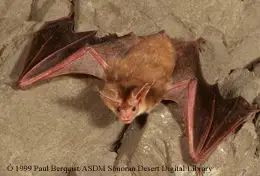Are you ready to meet your new favorite bat species?
Say hello to the Pallid Bat (Antrozous pallidus)!

Named for its generally pale yellow to white coloring, the Pallid Bat is an accomplished hunter. They use their unusually large ears to listen for the sounds of prey running on the ground. When they detect the sound of prey, they will land on the ground to capture their next.
Meals generally include a range of arthropods, including crickets, grasshoppers, beetles, and most impressively, scorpions! Pallid bats even appear to be resistant to scorpion stings, even from some of the most venomous scorpions found in North America!
Video of a Pallid Bat hunting a scorpion. Recorded by Dr. Winifred Frick/Bat Conservation International
But these adaptable bats don’t stop there! Pallid bats will also snack on the nectar and fruits of cactus, particularly in their southern range in Baja California. Since they have to land on the flowers and subsequently get covered in pollen, they are actually better at pollinating cactus flowers than more specialized bats species!
They will also feed on the fruits of cardón cactus (Pachycereus pringlei), though their table manners leave something to be desired.
Series of videos showing pallid bats visiting a cardon cactus fruit in Baja California. In the third clip, you can watch the bat try to get its’ head unstuck from inside the fruit. Video by Dr. Jaclyn Aliperti.
Good lucks, venom-resistant super-powers AND helpful pollinators? What more could you want in a bat?
Literature Cited:
– Venom resistance in Pallid Bats: Hopp, B. H., Arvidson, R. S., Adams, M. E., & Razak, K. A. (2017). Arizona bark scorpion venom resistance in the pallid bat, Antrozous pallidus. PLoS One, 12(8), e0183215.
– Pollination by Pallid Bat: Frick, Winifred F.; Price, Ryan D.; Heady III, Paul A.; Kay, Kathleen M. (3 December 2012). “Insectivorous bat pollinates columnar cactus more effectively per visit than specialized nectar bat”. The American Naturalist. 181 (1): 137–144.
– Fruit eating by Pallid Bats: Aliperti, Jaclyn R.; Kelt, Douglas A.; Heady, Paul A.; Frick, Winifred F. (21 March 2017). “Using behavioral and stable isotope data to quantify rare dietary plasticity in a temperate bat”. Journal of Mammalogy. 98 (2): 340–349.